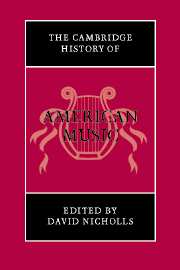Book contents
- Frontmatter
- PART ONE
- PART TWO
- 10 Music in America: an overview (part 2)
- 11 Immigrant, folk, and regional musics in the twentieth century
- 12 Popular song and popular music on stage and film
- 13 The rock and roll era
- 14 Ragtime and early jazz
- 15 Jazz from 1930 to 1960
- 16 Jazz since 1960
- 17 Tonal traditions in art music from 1920 to 1960
- 18 Serialism and complexity
- 19 Avant-garde and experimental music
- 20 Tonal traditions in art music since 1960
- Bibliography and references
- Index
- References
15 - Jazz from 1930 to 1960
from PART TWO
Published online by Cambridge University Press: 28 March 2008
- Frontmatter
- PART ONE
- PART TWO
- 10 Music in America: an overview (part 2)
- 11 Immigrant, folk, and regional musics in the twentieth century
- 12 Popular song and popular music on stage and film
- 13 The rock and roll era
- 14 Ragtime and early jazz
- 15 Jazz from 1930 to 1960
- 16 Jazz since 1960
- 17 Tonal traditions in art music from 1920 to 1960
- 18 Serialism and complexity
- 19 Avant-garde and experimental music
- 20 Tonal traditions in art music since 1960
- Bibliography and references
- Index
- References
Summary
The beginning of the twentieth century marked the first true infiltration of African American music into popular culture. Through the medium of sheet music, piano ragtime won the general public over to lively syncopated music in duple meter. It was arguably the first “youth music,” embraced by young people of the day and a cause for concern to their parents. A generation later, the African American music that came to be called “jazz” emerged from New Orleans and was proliferated primarily in the commercial music centers of Chicago and New York. The Great Depression that began in 1929 threatened to bring an end to jazz, but it reemerged in the 1930s more popular than ever and sporting a new name – “swing.”
Benny Goodman (1909–1986) is the figure who most readily comes to mind when marking the beginning of the “Swing Era.” He gave the popularization of swing jazz big bands its momentum; but he was not a stylistic originator, anymore than Scott Joplin originated ragtime or W. C. Handy originated the blues. Goodman culminated a long process that changed the context, format, and very nature of jazz. The “King of Swing” built his empire on a foundation laid by a number of innovative black and white musicians from across the United States.
More than any other entity, the Casa Loma Orchestra convinced Goodman to form his own band. The group began life as the Orange Blossoms, part of the Detroit network of bands overseen by Jean Goldkette. (This network also included McKinney’s Cotton Pickers, the band that hired arranger Don Redman away from Fletcher Henderson in 1927.)
- Type
- Chapter
- Information
- The Cambridge History of American Music , pp. 418 - 447Publisher: Cambridge University PressPrint publication year: 1998

